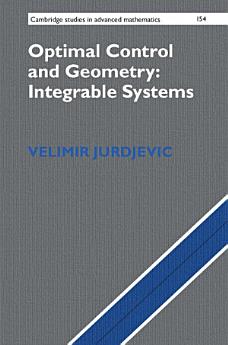Optimal Control and Geometry: Integrable Systems
Velimir Jurdjevic
កក្កដា 2016 · Cambridge Studies in Advanced Mathematics សៀវភៅទី 154 · Cambridge University Press
សៀវភៅអេឡិចត្រូនិច
437
ទំព័រ
reportការវាយតម្លៃ និងមតិវាយតម្លៃមិនត្រូវបានផ្ទៀងផ្ទាត់ទេ ស្វែងយល់បន្ថែម
អំពីសៀវភៅអេឡិចត្រូនិកនេះ
The synthesis of symplectic geometry, the calculus of variations and control theory offered in this book provides a crucial foundation for the understanding of many problems in applied mathematics. Focusing on the theory of integrable systems, this book introduces a class of optimal control problems on Lie groups, whose Hamiltonians, obtained through the Maximum Principle of optimality, shed new light on the theory of integrable systems. These Hamiltonians provide an original and unified account of the existing theory of integrable systems. The book particularly explains much of the mystery surrounding the Kepler problem, the Jacobi problem and the Kovalevskaya Top. It also reveals the ubiquitous presence of elastic curves in integrable systems up to the soliton solutions of the non-linear Schroedinger's equation. Containing a useful blend of theory and applications, this is an indispensable guide for graduates and researchers in many fields, from mathematical physics to space control.
អំពីអ្នកនិពន្ធ
Professor Velimir Jurdjevic is one of the founders of geometric control theory. His pioneering work with H. J. Sussmann was deemed to be among the most influential papers of the century and his book, Geometric Control Theory, revealed the geometric origins of the subject and uncovered important connections to physics and geometry. It remains a major reference on non-linear control. Jurdjevic's expertise also extends to differential geometry, mechanics and integrable systems. His publications cover a wide range of topics including stability theory, Hamiltonian systems on Lie groups, and integrable systems. He has spent most of his professional career at the University of Toronto.
វាយតម្លៃសៀវភៅអេឡិចត្រូនិកនេះ
ប្រាប់យើងអំពីការយល់ឃើញរបស់អ្នក។
អានព័ត៌មាន
ទូរសព្ទឆ្លាតវៃ និងថេប្លេត
ដំឡើងកម្មវិធី Google Play Books សម្រាប់ Android និង iPad/iPhone ។ វាធ្វើសមកាលកម្មដោយស្វ័យប្រវត្តិជាមួយគណនីរបស់អ្នក និងអនុញ្ញាតឱ្យអ្នកអានពេលមានអ៊ីនធឺណិត ឬគ្មានអ៊ីនធឺណិតនៅគ្រប់ទីកន្លែង។
កុំព្យូទ័រយួរដៃ និងកុំព្យូទ័រ
អ្នកអាចស្ដាប់សៀវភៅជាសំឡេងដែលបានទិញនៅក្នុង Google Play ដោយប្រើកម្មវិធីរុករកតាមអ៊ីនធឺណិតក្នុងកុំព្យូទ័ររបស់អ្នក។
eReaders និងឧបករណ៍ផ្សេងទៀត
ដើម្បីអាននៅលើឧបករណ៍ e-ink ដូចជាឧបករណ៍អានសៀវភៅអេឡិចត្រូនិក Kobo អ្នកនឹងត្រូវទាញយកឯកសារ ហើយផ្ទេរវាទៅឧបករណ៍របស់អ្នក។ សូមអនុវត្តតាមការណែនាំលម្អិតរបស់មជ្ឈមណ្ឌលជំនួយ ដើម្បីផ្ទេរឯកសារទៅឧបករណ៍អានសៀវភៅអេឡិចត្រូនិកដែលស្គាល់។







